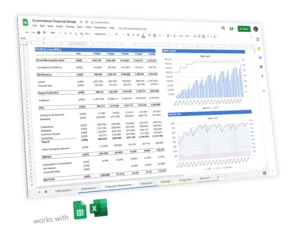Understanding PC1, PC2 and PC3 for Ecommerce

Ecommerce businesses have a very specific financial structure which is reflected in their profit-and-loss (P&L). We at SharpSheets use this fairly common P&L structure in our ecommerce and ecommerce subcription templates. Let’s review what they are and why they are important in tracking your ecommerce business’ profitability.
What does PC stands for?
PC stands for “Profit Contribution”. In other words, we segment all the different ecommerce revenues and expenses in your P&L in their respective profit contribution categories.
By definition PC is a profit measure in your P&L: revenues – costs.
By default, PC1 is above PC2, which is above PC3. As such PC3 typically is the lowest margin of all 3 as it includes all expenses down to PC3 which are also included within PC1 and PC2.
When using PC, we typically refer to PC margin (the percentage margin of total revenues). For instance, if revenues in 2021 are $100k and PC1 is $60k, PC1 margin is 60%.
Profit Contribution 1 (PC1)
PC1 is the sum of your revenues minus all direct expenses related to the sourcing of your products and services from your supplier. In the scenario where you would manufacture part or entirely your products or services, include any manufacturing expenses in there as well. In other words, PC1 is equal to revenues minus COGS.
As such, PC1 is the same thing as Gross Profit.
PC1 = Gross Profit = Revenues – COGS
Typically COGS for ecommerce include:
- Unit costs: the direct costs you incur to manufacture and/or source and ship the product from your supplier to your warehouse (if any)
- Shipping costs (from supplier to you). Only include the shipping costs (including customs and taxes) you incur on top of the product cost itself when shipping from your supplier’s warehouse to yours. If you use a outsourced fulfilment provider (e.g. Amazon FBA), include the costs to ship the products from your supplier to your fulfilment provider if possible.
- Allowance of bag goods
Profit Contribution 2 (PC2)
PC2 includes all direct expenses related to the fulfilment and delivery of your products and services.
PC2 = PC1 – all fulfilment-related costs
Expenses include:
- Fulfilment costs: shipping, packaging, warehousing (rent), and fulfilment itself (salaries of the operators who prepare the orders for instance)
- Payment processing fees: the 2-3% you pay to Stripe and Paypal for instance
- Customer support. Any cost related to customer service pre shipping and/or delivery needs to be included as part of PC2. Ideally you should exclude here after-sale related customer support which falls into PC3 instead.
Profit Contribution 3 (PC3)
PC3 includes all indirect overhead expenses such as marketing, administrative and tech costs down to EBITDA.
Typically, expenses included within PC3 and excluded from PC1 and PC2 are:
- Marketing expenses: salaries, digital ads campaigns, etc.
- After-sale customer success
- Payroll expenses that are not related to fulfilment: management, operations, tech team, etc.
- Any other expenses: office supplies, rent, legal advisory, bank fees, miscellaneous, etc.
Conclusion
PC1, PC2 and PC3 are different layers within your P&L and define your ecommerce business’ profitability looking at it from different angles.
What is causing a drop in profits? Is it an increase in fulfilment costs or marketing spend? Understanding the differences between PC1, PC2 and PC3 will allow you to understand the intricacies of your financial and make better decisions.
Are you looking for a great financial model template for your ecommerce business? Have a look at our template here. You don’t need a solid finance background, we made it easy: the 3 financial statements including your P&L and the different PC margins are pre-built, simply fill in your assumptions and visualise your metrics in a breeze.



